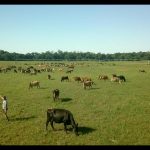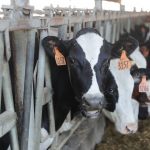
U.S. dairy farmers are still putting plenty of milk in the tank but not quite as much as expected.
The 24-State total was 18.1 billion pounds, up 3.2%. Revisions added 5 million pounds to the May 50-State estimate, now put at 19.86 billion pounds, up 4.7% from a year ago, instead of the originally reported 4.6%.
June cow numbers were down 1,000 head from May, first time in 11 months they didn’t top those a year ago. The herd totaled 9.51 million head in the 50 states, up 153,000 from June 2020 and up 63,000 from January. May cow numbers were revised up 4,000 head.
June output per cow averaged 1,994 pounds, up 26 pounds or 1.3% from 2020.
California was up 103 million pounds or 3.1% from a year ago, thanks to a 60 pound gain per cow. Cow numbers mirrored those a year ago. Wisconsin was up 73 million pounds or 2.8%, on a 30 pound gain per cow and 17,000 more cows.
Idaho was up 3.6%, on 14,000 more cows and 30 pounds more per cow. Michigan was up 4%, on 17,000 more cows. Output per cow was unchanged. Minnesota was up 3.2%, despite a drop of 25 pounds per cow, but the additional 20,000 cows made up the difference. New Mexico was up 4.3%, on a 90 pound gain per cow, but cow numbers were down 1,000 head.
New York produced 3.1% more milk than a year ago, thanks to a 50 pound gain per cow and 4,000 more cows. Oregon was up 0.5% on 2,000 more cows but output per cow was down 20 pounds. Pennsylvania was down 1.2%, on a drop of 7,000 cows, and output per cow was only up 5 pounds.
South Dakota again had the biggest gain, up 14.7%, on 20,000 more cows though output per cow was unchanged. Second place went to Indiana, up 8.3%, thanks to 16,000 more cows milked. Output per cow was down 10 pounds. Texas was up 7.0%, inspired by 34,000 more cows and a 25 pound gain per cow.
Vermont was up 0.5% on a 65 pound gain per cow but cow numbers were down 4,000. Washington State had the second largest decline of the five states showing a loss, second only to Virginia, and down 2.7%, despite a 35 pound gain per cow. Cow numbers were down 3,000.
StoneX points out that solids content is still running strong with fat and protein up 1.3% from last year.
Dairy cow culling picked up in June and topped that of a year ago. The USDA’s latest Livestock Slaughter report shows an estimated 237,500 head were sent to slaughter under federal inspection, up 14,100 head from May and 10,500 or 4.6% above June 2020. Culling in the half of the year totaled 1.56 million head, down 29,100 or 1.8% from the same period a year ago.
Growing U.S. butter stocks remain a concern though the growth slowed some in June. The Agriculture Department’s latest Cold Storage report showed the June 30 butter inventory at a whopping 414.5 million pounds, up 2.6 million pounds or 0.6% from May, which was revised up 10.1 million pounds, and was a weighty 52 million pounds or 14.4% above June 30, 2020. We’ll learn what June butter output looked like in the next Dairy Products report issued August 4.
American type cheese fell to 809.4 million pounds, down 18.3 million or 2.2% from the May level, which was revised down 3 million pounds from last month’s report, but stocks are up 16.4 million pounds or 2.1% from a year ago.
The “other” cheese category stocks slipped to 603.0 million pounds, down 5.5 million pounds or 0.9% from May, but was 4.1 million or 0.7% above a year ago. Revisions reduced the May inventory by 4.3 million pounds.
The total cheese inventory fell to 1.435 billion pounds, down 23.1 million pounds or 1.6% from May but 19 million pounds or 1.3% above a year ago.
Just as renewed COVID fears regarding the Delta variant started the week of July 19 by puling markets lower, dairy economics did not improve on the world market as powdered products pulled the week’s Global Dairy Trade auction lower for the seventh consecutive session. The GDT’s weighted average was down 2.9%, which followed the 3.6% plunge on July 6.
The losses were led by lactose, down 8.9%, after not trading on July 6. Skim milk powder was down 5.2%, following a 7.0% downfall on July 6, and whole milk powder was down 3.8% after a 3.0% descent. Butter inched 0.8% lower, after falling 3.2%, and anhydrous milkfat was off 0.3%, after it slipped 0.9% last time. The good news was that Cheddar was up 1.3%, after dropping 9.2% last time.
StoneX says the GDT 80% butterfat butter price equates to $1.9554 per pound U.S., down 1.7 cents, and got a little closer to CME butter which closed Friday at a bargain $1.6950. GDT Cheddar, at $1.8246, was up 3.3 cents, after plunging 17.2 cents last time, and compares to Friday’s CME block Cheddar at a bargain $1.5850. GDT skim milk powder averaged $1.3476 per pound, down from $1.4182. Whole milk powder averaged $1.6920 per pound, down from $1.7525. CME Grade A nonfat dry milk closed Friday at $1.2525 per pound.
StoneX’s Dustin Winston says North Asia, which includes China, and Africa were the only regions to purchase less volume Tuesday, compared to year-ago levels. North Asia also purchased less volume than the last event.
Speaking of China, June dairy imports remained strong and record breaking, according to Lucas Fuess, Director of Dairy Market Intelligence for Chicago-based HighGround Dairy (HGD), in the July 26 Dairy Radio Now broadcast.
Whole milk powder totaled 149.5 million pounds, up 86.9% from June 2020, with year to date up 28.2%. Skim milk powder imports, at 75.5 million pounds, were up 46.6% from a year ago and up 46.7% YTD.
Whey imports totaled 121.5 million pounds, down 1.1% from a year ago, however YTD whey is up 44.3%. HGD says this was the first decline since January 2020, with volume dropping to the weakest of any month since May 2020. Imports from the U.S. weakened slightly but the U.S. again claimed the most market share.
Butter imports, at 18.9 million pounds, were up 79.6% from 2020, with YTD up 21.3%. Cheese totaled 32.5 million, up 18.5% from 2020 and up 56.6% YTD.
Fuess said that COVID has spurred China’s purchases as it builds inventory to meet its growing demand and to stay ahead of logistical and shipping challenges that resulted from the pandemic.
Speaking to the continuing declines at the GDT, Fuess said he believes China is buying product off of the GDT and, with other regions not stepping up to buy, it caused prices to falter but reminds us those prices are off multi year highs. He says he expects continued good dairy demand internationally however it remains to be seen if that demand will keep up with the world’s growing milk supply.
Meanwhile the July 20 Daily Dairy Report detailed a new free trade agreement in principle between Australia and the United Kingdom. The post-Brexit plan would eliminate tariffs on dairy products within five years and establish interim quotas, according to the DDR. “The United Kingdom, the world’s second largest importer of dairy products, purchased 1.3 million metric tons in 2019, with EU members supplying 99% of those products, according to Dairy Australia.”
CME dairy prices saw ups and downs, though perhaps encouraged some by the Milk Production and Cold Storage reports. The Cheddar blocks fell to $1.5225 per pound Wednesday, lowest since June 28, but rallied to close Friday at $1.5850, still down 3 cents on the week and 95.50 cents below a year ago.
The barrels fell to $1.3725 Wednesday, lowest since Aug. 24, 2020, but finished Friday at $1.4025, 3.75 cents lower on the week, $1.0475 below a year ago, and 18.15 cents below the blocks. The week’s trading consisted of 1 car of block and 35 of barrel.
Midwestern cheesemakers tell Dairy Market News that market tones are not matching demand and their respective inventory levels and a number say customer interests are strengthening. Barrel producers say they are slightly over-committed and told customers that availability into August would be more limited.
Western retail and food service cheese demand is holding steady, as are exports, thanks to the lower prices. Contacts report a need to move product quickly, as warehouse space is limited. Delays have led to a stock buildup thanks to a shortage of truck drivers, limited shipping supplies, and port congestion.

























